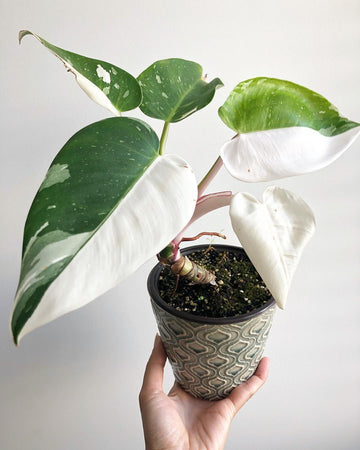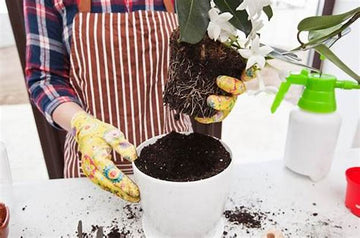If you’re a fan of variegated plants, the white wizard Philodendron is one that you will definitely want to add to your wish list. This Philodendron erubescens hybrid has exploded in popularity over the past few years along with other rare variegated houseplants like the pink princess Philodendron, Monstera Thai constellation, and Monstera albo, among others. This tropical plant is difficult to find and usually comes with a hefty price tag, but one glance at its stunning variegation will show you why. If you do manage to get your hands on one, be aware that like all Philodendrons, the white wizard is considered toxic to both pets and humans if ingested.
Light
To encourage the most vigorous growth and the best variegation, the white wizard Philodendron should be placed in a location that receives several hours of bright, indirect light. Variegated plants require more light than their non-variegated counterparts since their leaves have less chlorophyll, so while many Philodendron varieties can tolerate low-light conditions, this hybrid is not one of them. At the same time, harsh sunlight can easily damage this plant’s delicate leaves, so avoid direct sun where possible.
Soil
Like most Philodendrons, white wizard Philodendrons do best in rich, well-draining potting mixes. A mixture of equal parts indoor potting soil, perlite, and orchid bark mix is nutrient-dense and well-draining while still retaining some moisture. Plus, it’s easy and affordable to make yourself. Try making a big batch so you have some of this potting mix on hand whenever one of your Philodendrons needs to be repotted.
Water
White wizard Philodendrons are sensitive to overwatering and should be allowed to dry out slightly between waterings. Wait until the top 50% of the potting mix is dry and then water thoroughly, allowing any excess water to drain from the pot’s drainage holes.
Temperature and Humidity
These tropical plants are not cold-tolerant and prefer consistently warm conditions. This makes them ideal houseplants as they thrive in average household temperatures. While white wizard Philodendrons also grow well in average household humidity levels, they will thrive if provided with some added humidity. Try placing a humidifier nearby or growing your plant on a small pebble tray. Alternatively, naturally humid rooms like the bathroom or laundry room are great locations for this tropical plant.
Fertilizer
Regular fertilization is key to encouraging healthy variegated growth. During the spring and summer, apply a diluted balanced liquid fertilizer every two to three weeks during watering. Stop fertilizing during the fall and winter when the plant is no longer actively growing.
Pruning
Pruning is not necessary for this climbing Philodendron but may be desired to control growth or encourage fresh variegation. Ensure that any pruning is done during the plant’s active growing period— spring or summer—as the plant is less likely to recover from pruning when it is dormant in fall or winter. Additionally, always make sure that you use pruning shears or scissors that have been freshly sterilized to avoid accidentally introducing harmful bacteria to your plant. Most importantly, don’t throw away those stem cuttings! They can be used to propagate and grow new plants.
Propagating White Wizard Philodendron
Although it may feel nerve-wracking, propagating white wizard Philodendron is actually pretty easy to do. With a little practice, you’ll be propagating your plant regularly! Like many other vining Philodendrons, it is propagated by stem cuttings, although many growers choose to use sphagnum moss rather than water when it comes to rooting the cuttings. Here’s how you can propagate your white wizard Philodendron in just a few steps:
- Before beginning, soak the dried sphagnum moss in a bowl of water for at least 15 minutes to rehydrate it.
- Using a pair of sharp, sterilized pruning shears or scissors take one or more stem cuttings from a healthy white wizard Philodendron plant. Ensure that each stem cutting has at least three to four nodes. Each cutting should have at least one leaf as well.
- Remove the bottom leaves from the stem cutting to expose the nodes, leaving at least one leaf on top.
- Remove the sphagnum moss from the water and wring it out to remove as much of the water as possible. The moss should be moist but not soaking.
- Place the moist sphagnum moss in a small container and put the cuttings in the moss so that the bare stem is covered with the moss while the remaining leaf/leaves are sitting above the moss.
- Cover the container with a clear plastic bag to create a greenhouse-like environment.
- Put the container in a warm, humid location that receives several hours of bright, indirect light.
- Check back periodically to ensure that the moss remains moist and does not dry out. The cutting should begin rooting after a couple of weeks. Once it has established some roots, you can remove the plastic bag.
- Once the roots are at least an inch long the cutting can be transferred from moss to soil. Prepare a pot with a well-draining potting mix and transfer the rooted cutting to the soil. Don’t worry too much about getting all of the moss off the roots—you don’t want to break them! Water the freshly potted cutting well and place it back in its original location.
- Keep the potting mix evenly moist for the first one to two weeks to help the roots acclimate, and then resume a regular watering schedule.
Potting and Repotting White Wizard Philodendron
White wizard Philodendron should be repotted once every one to two years in the spring or summer. Choose a pot that is two to four inches larger than your plant’s previous container and repot your plant with plenty of fresh, well-draining soil mix. After repotting, ensure that you return your plant to its original location and water thoroughly, allowing any excess water to drain from the pot’s drainage holes.
Common Pests and Plant Diseases
When it comes to pests, watch out for some common houseplant pests like spider mites, thrips, fungus gnats, and scale which will all happily take up residence in this tropical plant if given the chance. Treat your plant with an appropriate insecticide or neem oil at the first sign of an infestation.
Additionally, like many Philodendrons, the white wizard Philodendron can develop fungal leaf spots which appear as small yellow, red/orange, or brown spots on its leaves. If you notice that your plant has developed leaf spot, there are a few steps you should take. First, move your plant away from any other houseplants to prevent the disease from spreading. Next, treat your plant with a copper-based fungicide to help combat the disease. Lastly, reduce humidity around the plant until the leaf spot has resolved. Humid conditions provide the perfect environment for bacteria to grow and thrive.
Like most houseplants, the white wizard Philodendron can develop root rot if it is overwatered. Ensure that your plant has adequate drainage (always use a pot with drainage holes) and allow the potting medium to dry slightly between waterings.
Common Problems With White Wizard Philodendron
Unless you have a lot of experience growing similar types of rare variegated aroids, it’s likely that you’ll encounter at least one of these problems as you are learning how to care for your white wizard. If you do, don’t worry. While these plants can be tricky to get the hang of they are pretty hardy and can bounce back easily.
Lack of Variegation
If your white wizard Philodendron is looking a little lackluster and not putting out the brilliant white variegation that its so known for, it’s likely because your plant is not receiving the right amount of light. It should be located directly in front of or within a few feet of a bright window (but not directly in the sun’s rays). If you are worried that your space doesn’t receive enough light, try adding a grow light into your setup to provide this Philodendron with enough light to begin variegating.
Leggy Growth
Leggy growth is another indication that your white wizard Philodendron needs more light. Unfortunately, leggy growth cannot be reversed. However you can take steps to ensure that the new growth goes back to normal. Move your plant to a brighter location or place it under a grow light to ensure that new growth is not leggy.
Yellow Leaves
Sometimes yellow leaves are just old leaves dying off to make way for new growth. However, other times yellow leaves can be an indication that something in your plant’s growing environment isn’t quite right. If the leaves turning yellow are new growth (towards the top of the plant) then this is likely the case. The most common culprits are a lack of light and under watering, although overwatering can also cause yellowing. Examine your plant’s growing environment to determine what the issue may be for your particular plant.
-
Is the white wizard Philodendron rare?
The white wizard Philodendron is a rare and highly sought-after Philodendron hybrid thanks to its unique variegation.
-
Is the white wizard Philodendron, Philodendron white princess, and Philodendron white knight the same plant?
While these three plants look very similar, they are in fact three separate Philodendron erubescens hybrids. These hybrids can be distinguished from one another primarily by the shape and size of their leaves, as well as the color of their stems and petioles. The white knight, similar to the pink princess Philodendron, has burgundy stems with round leaves while the white princess has pink variegation on its petioles along with more narrow leaves. In contrast, the white wizard Philodendron only has white variegation on its stems.
-
Should I mist the leaves of my white wizard Philodendron?
While this Philodendron enjoys humidity, misting is not a good idea. On top of being a relatively inefficient way to increase humidity around the plant, the water on the leaves can lead to fungal leaf spot which can damage your plant and is difficult to get rid of.




